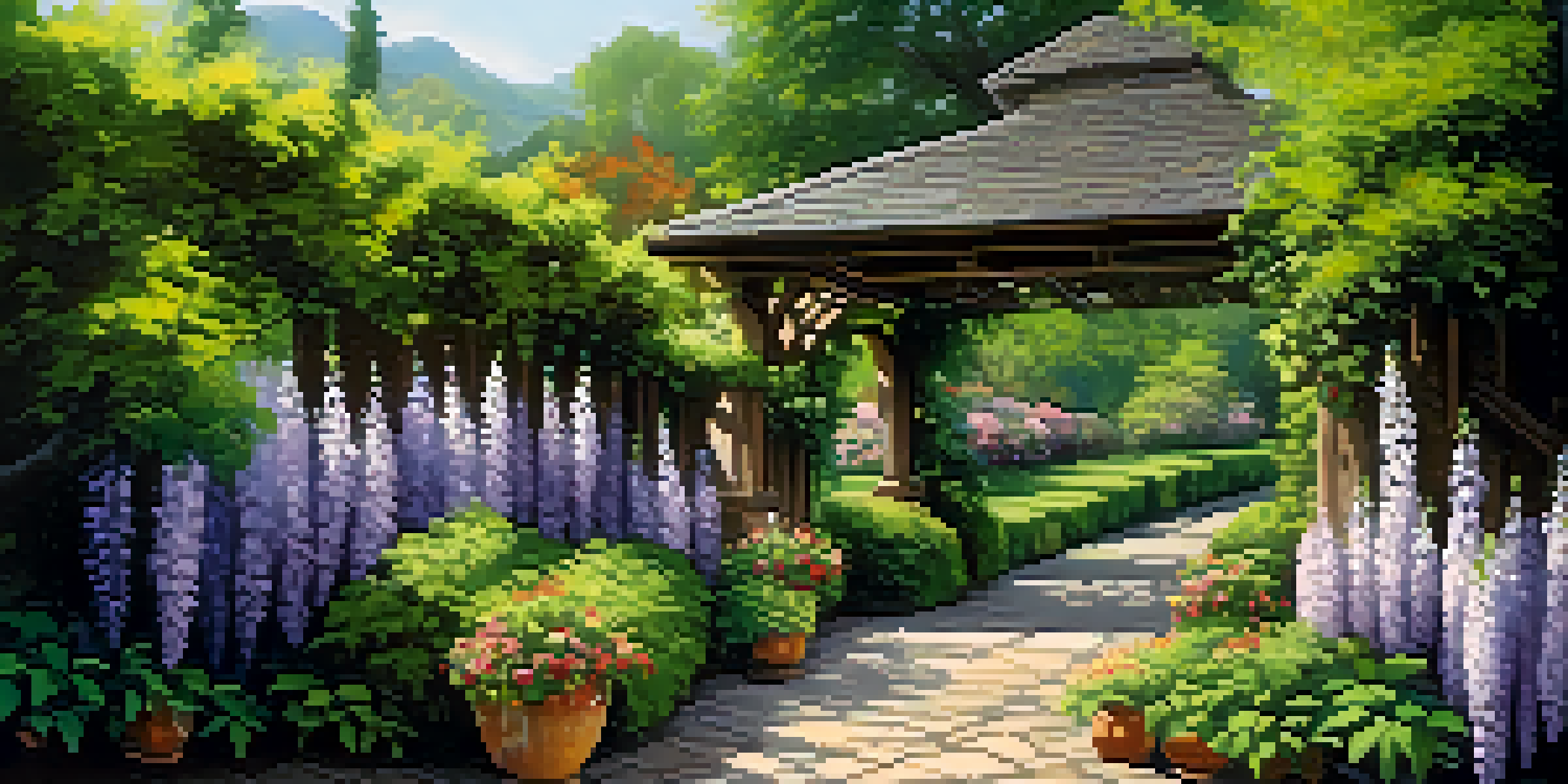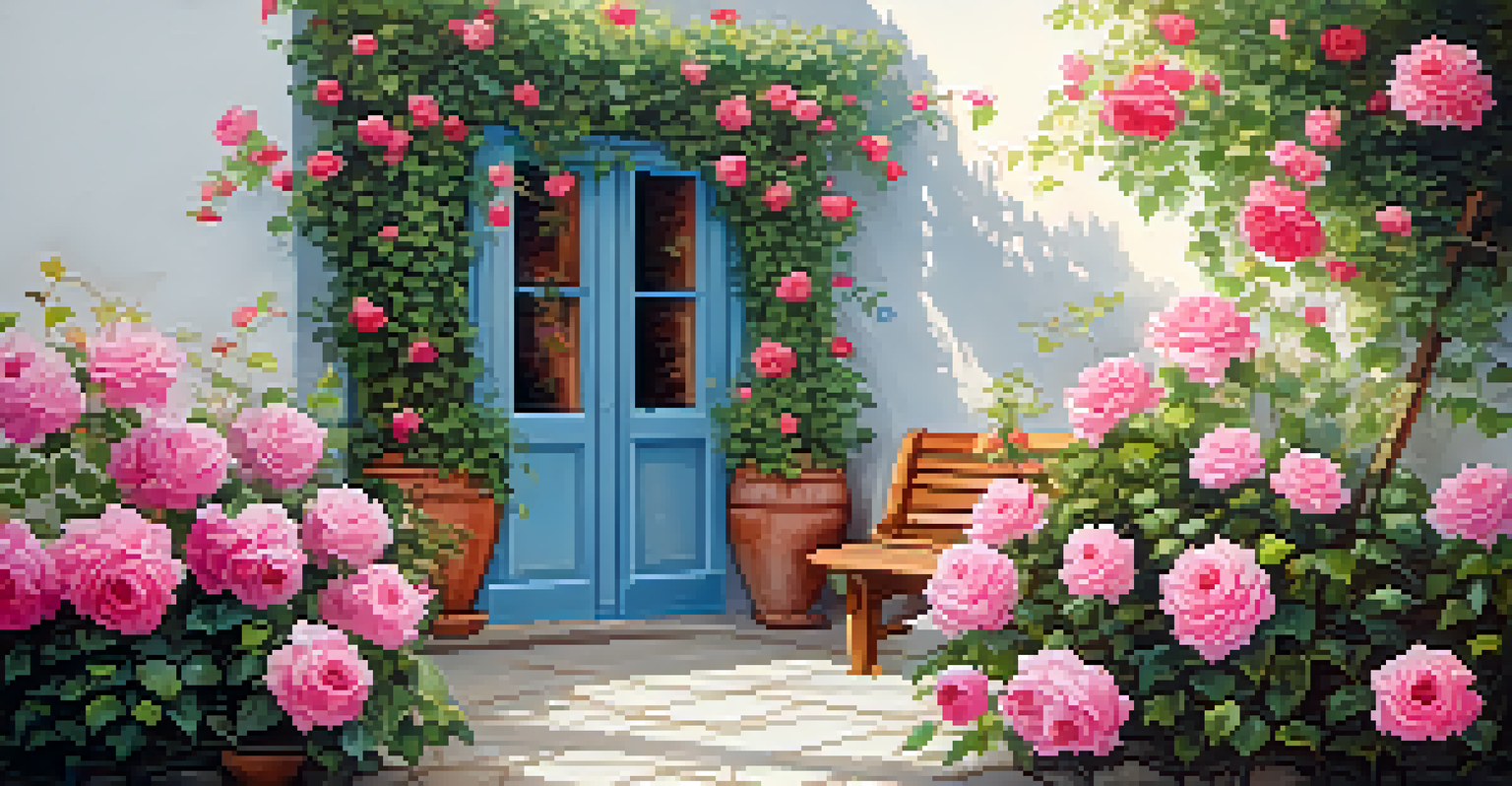How to Use Trellises and Arbors in Your Landscape Design

Understanding Trellises and Arbors in Landscaping
Trellises and arbors are not just decorative elements; they serve practical purposes in your garden design. A trellis is a framework, often made of lattice, that supports climbing plants, while an arbor is a larger structure that can create pathways or entrances. These features enhance verticality in your landscape, making even smaller spaces feel expansive and inviting.
The best thing about gardening is that you can get a little dirt on your hands and still feel like you're doing something good for the world.
Using these structures can also improve airflow and sunlight exposure for your plants, which is crucial for their growth. Imagine a trellis adorned with vibrant climbing roses or a rustic arbor draped in wisteria, creating a stunning focal point in your garden. Such elements can transform an ordinary yard into a lush, enchanting space.
Incorporating trellises and arbors opens up a world of possibilities for framing views and creating intimate outdoor areas. They can also provide privacy and shelter, making your garden feel like a personal retreat. Understanding their roles will help you integrate them effectively into your landscape design.
Choosing the Right Materials for Your Structures
When it comes to trellises and arbors, the materials you choose can significantly influence their durability and aesthetic appeal. Common options include wood, metal, and vinyl, each offering unique benefits. For instance, wooden structures add a natural warmth to your garden, while metal provides a modern, sleek look.

Consider the climate in your area when selecting materials. Trellises made from treated wood can withstand moisture and insects, while sturdier metal options can resist rust and corrosion. If longevity is a priority, vinyl is a low-maintenance choice that won't fade or rot over time.
Ultimately, the right material should complement your overall garden style. Whether you prefer the rustic charm of cedar or the contemporary feel of powder-coated steel, ensure that your choice aligns with your vision for your landscape. This thoughtful selection process enhances the cohesion of your design.
Designing with Trellises: Tips and Ideas
Incorporating trellises into your landscape design can be both fun and functional. One popular idea is to position them in strategic spots, such as along garden paths or against walls, to guide visitors through your outdoor space. This creates a sense of flow and draws the eye upward, showcasing your climbing plants.
Gardening adds years to your life and life to your years.
To maximize their impact, consider using trellises of varying heights and styles. A mix of tall and short trellises can add visual interest and dimension to your garden. You might even combine them with seating areas, allowing flowers and greenery to envelop your seating for a cozy atmosphere.
Don't forget to choose the right plants to climb your trellis. Fast-growing vines like clematis or morning glories can quickly create lush coverage. With a little planning, your trellis can become a living work of art, bursting with color and texture throughout the seasons.
Creating Arbors for Entryways and Pathways
Arbors can serve as stunning entry points or focal features within your garden, guiding guests from one area to another. Placing an arbor at the entrance of a pathway can create a sense of anticipation and welcome. Imagine walking through a beautifully adorned arbor, with fragrant flowers cascading overhead, inviting you deeper into the garden.
To enhance the experience, consider incorporating seating or decorative elements around the arbor. This could be a small bench or even a couple of planters filled with seasonal blooms. These additions not only beautify the space but also create cozy nooks for relaxation and contemplation.
Additionally, arbors can be adorned with climbing plants, such as honeysuckle or jasmine, which add fragrance and beauty. As these plants grow, they’ll create a lush, green canopy, providing dappled shade for those passing through. This transformation can turn a simple structure into an enchanting experience.
Plant Selection for Trellises and Arbors
Choosing the right plants for your trellises and arbors is crucial for achieving the desired look and feel in your landscape. Climbing vines, such as ivy or climbing roses, can create a beautiful tapestry of color and texture. It's essential to consider the growth habits of these plants to ensure they will thrive and not overwhelm the structure.
When selecting plants, think about the blooming season and the overall color palette you want to achieve. For instance, if you prefer a continuous bloom throughout the summer, consider plants like clematis, which offer an array of colors and varieties. This adds dynamism to your garden as different plants take their turn in the spotlight.
Additionally, be mindful of how much sunlight your chosen plants will receive. Some plants thrive in full sun, while others prefer partial shade. Pairing the right plants with your trellises and arbors not only enhances their beauty but also supports healthy growth and longevity.
Maintenance Tips for Trellises and Arbors
Maintaining your trellises and arbors is essential to ensure they last for years while looking their best. Regular inspections for signs of wear, such as rust or rot, are crucial, especially for wooden structures. A fresh coat of paint or sealant can go a long way in protecting these structures from the elements.
Pruning the climbing plants is equally important. Regular trimming helps maintain the health of the plants and prevents them from becoming too unruly. This not only keeps your garden looking neat but also encourages better blooms and growth, enhancing the overall aesthetic of your landscape.
Lastly, consider seasonal care based on your local climate. In colder climates, you might need to wrap or shelter your plants during winter. By staying proactive with maintenance, your trellises and arbors can continue to be stunning features in your landscape for many seasons to come.
Incorporating Trellises and Arbors in Small Spaces
Even if you have a small garden, trellises and arbors can be valuable additions that maximize your space. Vertical gardening is an excellent solution for creating a lush environment without taking up too much ground area. A well-placed trellis can transform a bland wall into a vibrant canvas of climbing greens and blooms.
In small spaces, consider using multi-functional structures. For example, an arbor can double as a seating area or a trellis can act as a privacy screen while supporting beautiful plants. This approach not only saves space but also enhances the usability of your garden.

Additionally, choose compact plant varieties that won’t overpower the space. Dwarf climbing roses or petite vines can add charm without overwhelming the area. With thoughtful planning, even the smallest garden can feel inviting and lush with the right use of trellises and arbors.